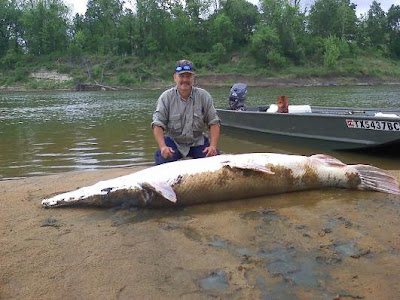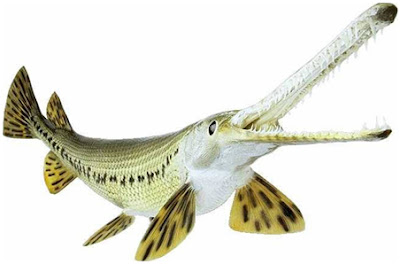“Garzilla” record sized Alligator Gar caught on Trinity River
Many biologists believe that overfishing and overhunting of the alligator gar on the Trinity River have severely impacted the size and population of the fish.
 |
| Joseph Williams with Trinity River water body record Alligator Gar 7′ 9″ 200+ pounds |
The Trinity River is the longest river wholly within the State of Texas. 45% of all Texans get their drinking water from the Trinity River watershed. It’s exciting to see such a large fish grow to such size in a river that humans have used and abused for so many decades.
 |
| TPWD staff with Garzilla the record alligator gar caught by rod and reel on the Trinity River |
The alligator gar is one of the largest freshwater fishes in North America and is the largest of the gar species. Gars are slow growing fish, with female alligator gars reaching sexual maturity around age 11 and living to age 50. Male alligator gars mature around age 6 and live at least 26 years. Alligator gars commonly grow to a size of 6 1/2ft and over 100 lbs. But have been reported to grow up to 350 lbs. The largest recorded alligator gar comes from the St. Francis River, Arkansas in the 1930’s, and weighed 350 lbs. The Alligator Gar above will easily break the State of Texas Trinity River water body record. What makes this gar exceptional is that the Alligator Gar Texas state record has stood for over 50 years.
 |
| Alligator Gar Atractosteus spatula |
Alligator gars appear sluggish, however they are voracious predators. Gars are ambush predators, primarily piscivores, they lay still in the water until an unsuspecting fish swims by, and then lunging forward and lashing the head from side to side in order to capture prey. Many times gars will lay still at the top of the water for long periods of time, appearing to be merely a log. The alligator gars’ diet consists primarily of fish. This gar is also known to prey on waterfowl and other birds, small mammals, turtles, and carrion. Alligator gars have been reported to attack duck decoys and eat injured waterfowl shot by hunters.
Due to its extremely large size, an adult alligator gar has few natural predators. Young gars are preyed upon by larger fish, but once they reach a size of about 3 feet their only natural predator would be an American alligator (Alligator mississippiensis). The alligator gar is rare, endangered, and has even gone extinct from many of the outer areas of its range. Studies in Alabama, Mississippi, and Louisiana have shown that the alligator gar is very susceptible to overfishing. It has been classified as rare in Missouri, threatened in Illinois, and endangered in Arkansas, Kentucky, and is soon to be in Tennessee.
Trinity River Alligator Gar research by TPWD indicates:
- Alligator gar live beyond 50 years.
- Alligator have a low natural mortality (less than 9 percent per year on average).
- There are an estimated 9,200 alligator gar 42 inches or longer in the upper Trinity (from below DFW to Lake Livingston).
- Estimated sustainable harvest from the Trinity would be about 400 alligator gar 42 inches or longer annually of which only 60 gar can be above 70 inches.
- There appears to be very limited movement between coastal alligator gar and those within the Trinity River. This suggests that localized overfishing may be possible in high-use areas.
- The estimated current rate of harvest for the upper Trinity is about 3 percent to 4 percent of the total population per year, which TPWD considers sustainable if recruitment is maintained.
- In the Trinity it takes about three to five years for alligator gar to reach a length of 42 inches and 20 to 50 years to reach a length of 78 inches.